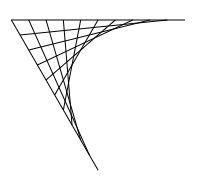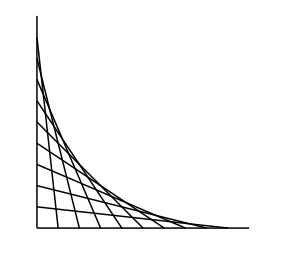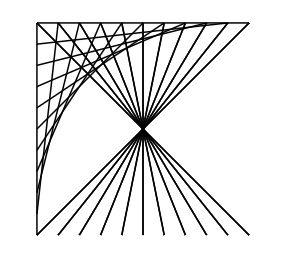Difference between revisions of "Graphics Render Examples"
| Line 57: | Line 57: | ||
[[File:Lines-poly4-lines12.jpg|thumb|left]] | [[File:Lines-poly4-lines12.jpg|thumb|left]] | ||
| − | < | + | <syntaxhighlight lang="javascript"> |
pointcoords=POLYPOINTS(4,100,100); | pointcoords=POLYPOINTS(4,100,100); | ||
s=LINESPLIT(pointcoords,10,true) | s=LINESPLIT(pointcoords,10,true) | ||
| Line 71: | Line 71: | ||
RENDER(d) | RENDER(d) | ||
"" | "" | ||
| − | </ | + | </syntaxhighlight> |
Four adjacent line sets are connected and rendered in this example. | Four adjacent line sets are connected and rendered in this example. | ||
[[File:Lines-poly4-lines01234.jpg|thumb|left]] | [[File:Lines-poly4-lines01234.jpg|thumb|left]] | ||
| − | < | + | <syntaxhighlight lang="javascript"> |
pointcoords=POLYPOINTS(4,100,100); | pointcoords=POLYPOINTS(4,100,100); | ||
s=LINESPLIT(pointcoords,10,true) | s=LINESPLIT(pointcoords,10,true) | ||
| Line 89: | Line 89: | ||
RENDER(d) | RENDER(d) | ||
"" | "" | ||
| − | </ | + | </syntaxhighlight> |
Just two opposite side point sets connected and rendered in this example. | Just two opposite side point sets connected and rendered in this example. | ||
[[File:Lines-poly4-cage0.jpg|thumb|left]] | [[File:Lines-poly4-cage0.jpg|thumb|left]] | ||
| − | < | + | <syntaxhighlight lang="javascript"> |
pointcoords=POLYPOINTS(4,100,100); | pointcoords=POLYPOINTS(4,100,100); | ||
s=LINESPLIT(pointcoords,10,true) | s=LINESPLIT(pointcoords,10,true) | ||
| Line 107: | Line 107: | ||
RENDER(d) | RENDER(d) | ||
"" | "" | ||
| − | </ | + | </syntaxhighlight> |
Two adjacent and two opposite lines point sets connected and rendered in this example. | Two adjacent and two opposite lines point sets connected and rendered in this example. | ||
[[File:Lines-poly4-lines1+cage0.jpg|thumb|left]] | [[File:Lines-poly4-lines1+cage0.jpg|thumb|left]] | ||
| − | < | + | <syntaxhighlight lang="javascript"> |
pointcoords=POLYPOINTS(4,100,100); | pointcoords=POLYPOINTS(4,100,100); | ||
s=LINESPLIT(pointcoords,10,true) | s=LINESPLIT(pointcoords,10,true) | ||
| Line 125: | Line 125: | ||
RENDER(d) | RENDER(d) | ||
"" | "" | ||
| − | </ | + | </syntaxhighlight> |
Four line sets and lines across are connected and rendered in this example. | Four line sets and lines across are connected and rendered in this example. | ||
[[File:Lines-poly4-lines01234+cage0213.jpg|thumb|left]] | [[File:Lines-poly4-lines01234+cage0213.jpg|thumb|left]] | ||
| − | < | + | <syntaxhighlight lang="javascript"> |
pointcoords=POLYPOINTS(4,100,100); | pointcoords=POLYPOINTS(4,100,100); | ||
s=LINESPLIT(pointcoords,10,true) | s=LINESPLIT(pointcoords,10,true) | ||
| Line 150: | Line 150: | ||
RENDER(d) | RENDER(d) | ||
"" | "" | ||
| − | </ | + | </syntaxhighlight> |
| Line 162: | Line 162: | ||
==Example 1 == | ==Example 1 == | ||
[[File:Wki cycloid1.jpg|thumb|left|Cycloid (fig.1)]] | [[File:Wki cycloid1.jpg|thumb|left|Cycloid (fig.1)]] | ||
| − | < | + | <syntaxhighlight lang="javascript"> |
numpoints = 50; | numpoints = 50; | ||
pts=MAKEPOLYGONPOINTS(numpoints,[50,50],[200,200], 270) | pts=MAKEPOLYGONPOINTS(numpoints,[50,50],[200,200], 270) | ||
| Line 176: | Line 176: | ||
] | ] | ||
)"" | )"" | ||
| − | </ | + | </syntaxhighlight> |
==Example 2 == | ==Example 2 == | ||
Rendering two cardioids. A smaller and a larger one. | Rendering two cardioids. A smaller and a larger one. | ||
[[File:Wki cycloid2.jpg|thumb|left|Two Cycloids (fig.2)]] | [[File:Wki cycloid2.jpg|thumb|left|Two Cycloids (fig.2)]] | ||
| − | < | + | <syntaxhighlight lang="javascript"> |
numpoints = 50; | numpoints = 50; | ||
pts=MAKEPOLYGONPOINTS(numpoints,[30,50],[200,200], 150) | pts=MAKEPOLYGONPOINTS(numpoints,[30,50],[200,200], 150) | ||
| Line 202: | Line 202: | ||
["cycloid2","circle",circlesat2.column(1),circlesat2.column(0),circlesat2.column(2),"red",1,circlesat2.length] | ["cycloid2","circle",circlesat2.column(1),circlesat2.column(0),circlesat2.column(2),"red",1,circlesat2.length] | ||
] );"" | ] );"" | ||
| − | </ | + | </syntaxhighlight> |
| Line 210: | Line 210: | ||
[[File:Bezier_Curves.png|thumb|left]] | [[File:Bezier_Curves.png|thumb|left]] | ||
| − | < | + | <syntaxhighlight lang="javascript"> |
RENDER | RENDER | ||
| Line 228: | Line 228: | ||
); | ); | ||
"" | "" | ||
| − | </ | + | </syntaxhighlight> |
Latest revision as of 02:32, 3 December 2020
Graphics Render Examples
Lines, Triangle and Rectangle
Points connecting two intersecting lines at an angle (or two sides of a triangle). Three sets of point coordinates for lines are generated with the function POLYPOINTS() and the lines are split to 10 segments to have ten points for each of the three line sets. Two lines are connected with the point sets on the lines diagonally opposite points
pointcoords=POLYPOINTS(3,100,100);
s=LINESPLIT(pointcoords,10,true)
lines1=(s[0].rowpush(s[1])).m(r=>r.flatten())
lines2=(s[1].rowpush(s[2])).m(r=>r.flatten())
lines3=(s[2].rowpush(s[0])).m(r=>r.flatten())
var d= [
["type","coordinates","count"],
["line",lines1,lines1.length],
]
RENDER(d) ""
Lines are connected with the point sets on the lines diagonally opposite all three line sets
pointcoords=POLYPOINTS(3,100,100);
s=LINESPLIT(pointcoords,10,true)
lines1=(s[0].rowpush(s[2])).m(r=>r.flatten())
lines2=(s[1].rowpush(s[0])).m(r=>r.flatten())
lines3=(s[2].rowpush(s[1])).m(r=>r.flatten())
var d= [ ["type","coordinates","count"],
["line",lines1,lines1.length],
["line",lines2,lines2.length],
["line",lines3,lines3.length] ]
RENDER(d) ""
Four sets of point coordinates for lines are generated with the function POLYPOINTS() and the lines are split to 10 segments to have ten points for each of the four line sets. Lines are rendered with the set of points and the type of object to render, given to the RENDER function.
pointcoords=POLYPOINTS(4,100,100);
s=LINESPLIT(pointcoords,10,true)
lines1=(s[0].rowpush(s[1])).m(r=>r.flatten())
lines2=(s[1].rowpush(s[2])).m(r=>r.flatten())
lines3=(s[2].rowpush(s[3])).m(r=>r.flatten())
lines4=(s[3].rowpush(s[0])).m(r=>r.flatten())
var d= [
["type","coordinates","count"],
["line",lines1,lines1.length]
]
RENDER(d)
""
Two adjacent line sets are connected and rendered in this example.
pointcoords=POLYPOINTS(4,100,100);
s=LINESPLIT(pointcoords,10,true)
lines1=(s[0].rowpush(s[1])).m(r=>r.flatten())
lines2=(s[1].rowpush(s[2])).m(r=>r.flatten())
lines3=(s[2].rowpush(s[3])).m(r=>r.flatten())
lines4=(s[3].rowpush(s[0])).m(r=>r.flatten())
var d= [ ["type","coordinates","count"],
["line",lines1,lines1.length],
["line",lines2,lines2.length]
]
RENDER(d)
""
Four adjacent line sets are connected and rendered in this example.
pointcoords=POLYPOINTS(4,100,100);
s=LINESPLIT(pointcoords,10,true)
lines1=(s[0].rowpush(s[1])).m(r=>r.flatten())
lines2=(s[1].rowpush(s[2])).m(r=>r.flatten())
lines3=(s[2].rowpush(s[3])).m(r=>r.flatten())
lines4=(s[3].rowpush(s[0])).m(r=>r.flatten())
var d= [ ["type","coordinates","count"],
["line",lines1,lines1.length],
["line",lines2,lines2.length],
["line",lines3,lines3.length],
["line",lines4,lines4.length] ]
RENDER(d)
""
Just two opposite side point sets connected and rendered in this example.
pointcoords=POLYPOINTS(4,100,100);
s=LINESPLIT(pointcoords,10,true)
lines1=(s[0].rowpush(s[2])).m(r=>r.flatten())
lines2=(s[2].rowpush(s[0])).m(r=>r.flatten())
lines3=(s[1].rowpush(s[2])).m(r=>r.flatten())
var d= [
["type","coordinates","count"],
["line",lines2,lines2.length]
]
RENDER(d)
""
Two adjacent and two opposite lines point sets connected and rendered in this example.
pointcoords=POLYPOINTS(4,100,100);
s=LINESPLIT(pointcoords,10,true)
lines1=(s[0].rowpush(s[2])).m(r=>r.flatten())
lines2=(s[2].rowpush(s[0])).m(r=>r.flatten())
lines3=(s[1].rowpush(s[2])).m(r=>r.flatten())
var d= [
["type","coordinates","count"],
["line",lines1,lines1.length],
["line",lines2,lines2.length],
["line",lines3,lines3.length]
]
RENDER(d)
""
Four line sets and lines across are connected and rendered in this example.
pointcoords=POLYPOINTS(4,100,100);
s=LINESPLIT(pointcoords,10,true)
lines1=(s[0].rowpush(s[1])).m(r=>r.flatten())
lines2=(s[1].rowpush(s[2])).m(r=>r.flatten())
lines3=(s[2].rowpush(s[3])).m(r=>r.flatten())
lines4=(s[3].rowpush(s[0])).m(r=>r.flatten())
lines5=(s[2].rowpush(s[0])).m(r=>r.flatten())
lines6=(s[1].rowpush(s[3])).m(r=>r.flatten())
var d= [
["type","coordinates","count"],
["line",lines1,lines1.length],
["line",lines2,lines2.length],
["line",lines3,lines3.length],
["line",lines4,lines4.length],
["line",lines5,lines5.length],
["line",lines6,lines6.length]
]
RENDER(d)
""
Cardioid Examples
Using the method: "midpoints of the circles lie on the perimeter of the fixed generator circle for the cardioid"
1) Choose a circle c and a point p on its perimeter, 2) Draw circles containing point p with centers on the perimeter of circle c
Example 1
numpoints = 50;
pts=MAKEPOLYGONPOINTS(numpoints,[50,50],[200,200], 270)
start=pts[0];
circlesat=
pts
.map(
p=>[p[0],p[1],SQRT(POWER(p[0]-start[0],2)+POWER(p[1]-start[1],2))]
)
RENDER( [
["type","cx","cy","r","stroke","stroke-width","count"],
["circle",circlesat.column(0),circlesat.column(1),circlesat.column(2),"red",1,circlesat.length]
]
)""
Example 2
Rendering two cardioids. A smaller and a larger one.
numpoints = 50;
pts=MAKEPOLYGONPOINTS(numpoints,[30,50],[200,200], 150)
start=pts[0];
circlesat1=
pts
.map(
p=>[p[0],p[1],SQRT(POWER(p[0]-start[0],2)+POWER(p[1]-start[1],2))]
)
pts=MAKEPOLYGONPOINTS(numpoints,[70,70],[500,200], 0)
start=pts[0];
circlesat2=
pts
.map(
p=>[p[0],p[1],SQRT(POWER(p[0]-start[0],2)+POWER(p[1]-start[1],2))]
)
cycloids = RENDER([
["id","type","cx","cy","r","stroke","stroke-width","count"],
["cycloid1","circle",circlesat1.column(1),circlesat1.column(0),circlesat1.column(2),"red",1,circlesat1.length],
["cycloid2","circle",circlesat2.column(1),circlesat2.column(0),circlesat2.column(2),"red",1,circlesat2.length]
] );""
Bezier Curves
To display various curves
RENDER
(
[
["type","coordinates","fill","stroke","stroke-width"],
["path", "M 70 10 C 70 20, 110 20, 110 10","transparent","black",5],
["path", "M 10 10 C 20 20, 40 20, 50 10","transparent","black",5],
["path", "M 130 10 C 120 20, 180 20, 170 10","transparent","black",5],
["path", "M 10 60 C 20 80, 40 80, 50 60","transparent","black",5],
["path", "M 70 60 C 70 80, 110 80, 110 60","transparent","black",5],
["path", "M 130 60 C 120 80, 180 80, 170 60","transparent","black",5],
["path", "M 10 110 C 20 140, 40 140, 50 110","transparent","black",5],
["path", "M 70 110 C 70 140, 110 140, 110 110","transparent","black",5],
["path", "M 130 110 C 120 140, 180 140, 170 110","transparent","black",5]
]
);
""










